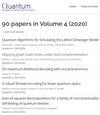Infinite quantum signal processing
IF 5.1
2区 物理与天体物理
Q1 PHYSICS, MULTIDISCIPLINARY
引用次数: 0
Abstract
Quantum signal processing (QSP) represents a real scalar polynomial of degree $d$ using a product of unitary matrices of size $2\times 2$, parameterized by $(d+1)$ real numbers called the phase factors. This innovative representation of polynomials has a wide range of applications in quantum computation. When the polynomial of interest is obtained by truncating an infinite polynomial series, a natural question is whether the phase factors have a well defined limit as the degree $d\to \infty$. While the phase factors are generally not unique, we find that there exists a consistent choice of parameterization so that the limit is well defined in the $\ell^1$ space. This generalization of QSP, called the infinite quantum signal processing, can be used to represent a large class of non-polynomial functions. Our analysis reveals a surprising connection between the regularity of the target function and the decay properties of the phase factors. Our analysis also inspires a very simple and efficient algorithm to approximately compute the phase factors in the $\ell^1$ space. The algorithm uses only double precision arithmetic operations, and provably converges when the $\ell^1$ norm of the Chebyshev coefficients of the target function is upper bounded by a constant that is independent of $d$. This is also the first numerically stable algorithm for finding phase factors with provable performance guarantees in the limit $d\to \infty$.无限量子信号处理
量子信号处理(QSP)使用大小为 2/times 2$ 的单元矩阵的乘积来表示阶数为 $d$ 的实标量多项式,其参数为称为相位因子的 $(d+1)$ 实数。这种创新的多项式表示法在量子计算中有着广泛的应用。当感兴趣的多项式是通过截断一个无穷多项式级数得到的时候,一个自然的问题是相位因子是否随着度数 $d\to \infty$ 有一个定义明确的极限。虽然相位因子一般不是唯一的,但我们发现存在一种一致的参数化选择,从而使极限在 $\ell^1$ 空间中定义良好。这种 QSP 的广义化被称为无限量子信号处理,可以用来表示一大类非多项式函数。我们的分析揭示了目标函数的规则性与相位因子的衰变特性之间的惊人联系。我们的分析还启发了一种非常简单高效的算法,可以近似计算 $\ell^1$ 空间中的相位因子。该算法只使用双精度算术运算,并且当目标函数的切比雪夫系数的 $\ell^1$ 准则的上界是一个与 $d$ 无关的常数时,该算法可以证明收敛。这也是第一个用于寻找相位因子的数值稳定算法,在极限 $d\to \infty$ 时具有可证明的性能保证。
本文章由计算机程序翻译,如有差异,请以英文原文为准。
求助全文
约1分钟内获得全文
求助全文
来源期刊

Quantum
Physics and Astronomy-Physics and Astronomy (miscellaneous)
CiteScore
9.20
自引率
10.90%
发文量
241
审稿时长
16 weeks
期刊介绍:
Quantum is an open-access peer-reviewed journal for quantum science and related fields. Quantum is non-profit and community-run: an effort by researchers and for researchers to make science more open and publishing more transparent and efficient.
 求助内容:
求助内容: 应助结果提醒方式:
应助结果提醒方式:


